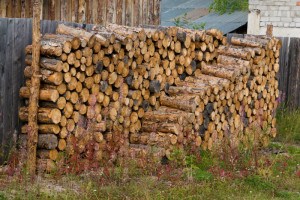When it comes to getting the most out of your fireplace, the kind of firewood you use makes a big difference. While buying the cheapest wood you can find, burning wood materials you have around the house, or using freshly cut logs might seem like money saving or easier options, doing so can have a negative impact on the efficiency of your fireplace. Instead, it is important to only burn seasoned firewood in your fireplace or stove.
Seasoned firewood is wood that has been cut into logs, stacked, and allowed to dry in the elements for between six months and one year. The main purpose of the seasoning process is to remove as much moisture as possible from the wood. Freshly cut wood has as much as 40-50% water; after seasoning, wood should have as little as 10-20% moisture left.
Removing the moisture from the wood during seasoning allows the wood to ignite faster, burn hotter, and produce less smoke. Likewise, seasoned wood produces smaller amounts of creosote buildup than freshly cut or green wood.
Why seasoned firewood is best
Seasoned firewood is the safest and most efficient fuel source for your wood burning fireplace or stove. There are a number of different firewood options; with a little bit of experimentation, homeowners can find the type of wood that produces the perfect amount of heat or has the most pleasant aroma!
Just because it is wood doesn’t mean it is meant to be burned; there are numerous wood products that are unsuitable for burning in a home fireplace. Green or freshly cut wood creates a sluggish, smoky fire, as well as contributes to large amounts of creosote buildup in the flue.
Prefabricated, painted, or pretreated wood should never be burned; this includes plywood and fencing or playground material. Because this wood is typically treated with sealants or protectants, it can release toxic chemicals into the air when burned.
How can I tell if my wood has been seasoned?
Once you know what to look for, it can be easy to spot the differences between freshly cut and seasoned firewood. The following are some ways to tell if wood has been seasoned or not.
- Weight. Because the moisture has evaporated, seasoned firewood is much lighter than freshly cut wood.
- Sound. When you hit two pieces of fresh wood together, they make a hard “thud” sound. When two seasoned logs are hit together, it makes a more hollow “clunk”.
- Appearance. The ends of freshly cut wood will be solid; if the wood was very recently cut, sap or moisture may still be present. Seasoned wood, however, will have darker, cracked, and split ends as the moisture has evaporated.
- Ask. If you are buying wood from a dealer or other vendor, they should be able to tell you what kind of wood you are purchasing, as well as when it was cut and how long it has been seasoned.
To get the most out of your fireplace, make sure you are using the right firewood. Seasoned firewood is the safest and most efficient burning option for your wood burning fireplace or stove; if you have questions about whether or not you are using the right kind of firewood, contact Magic Broom today!


